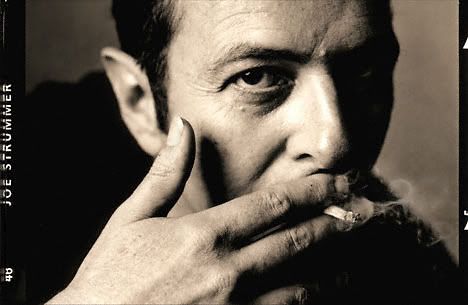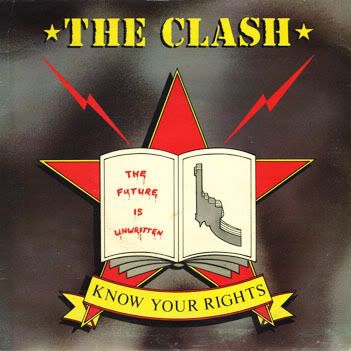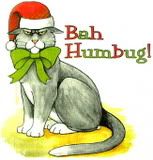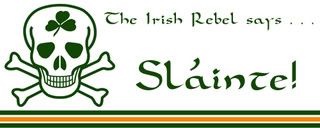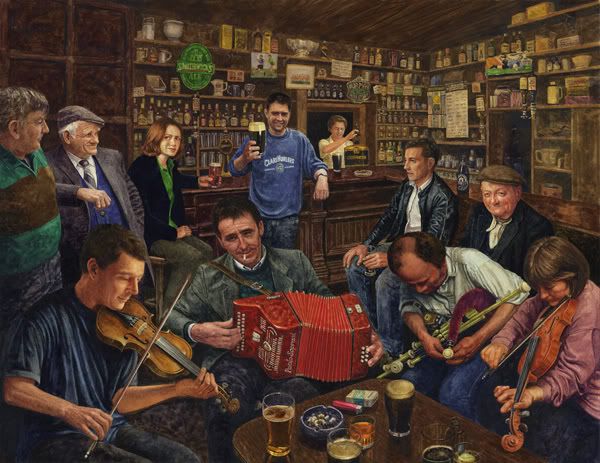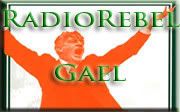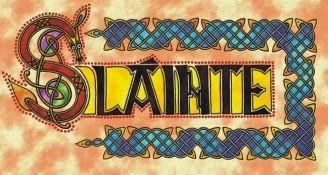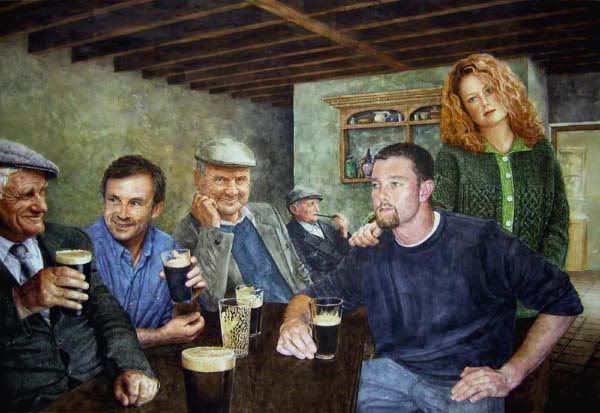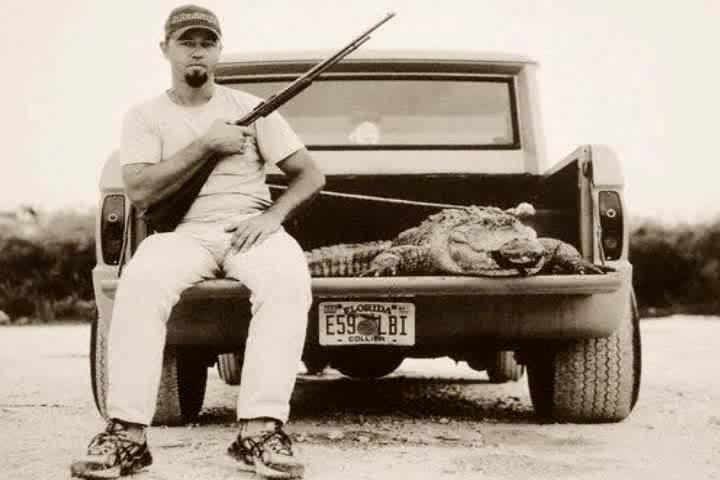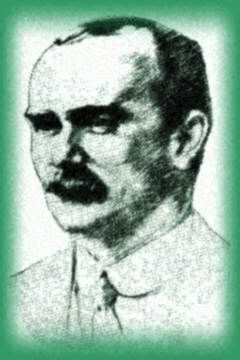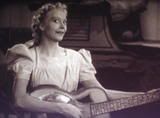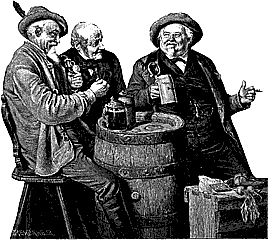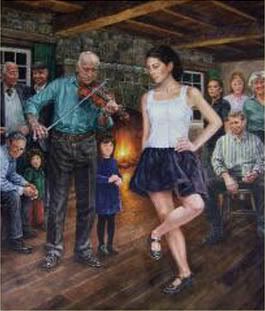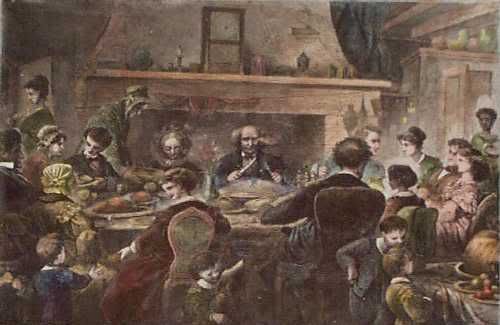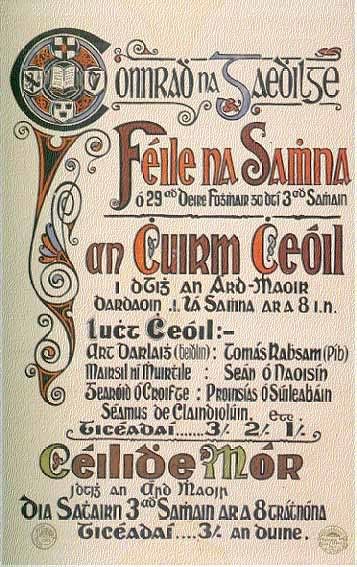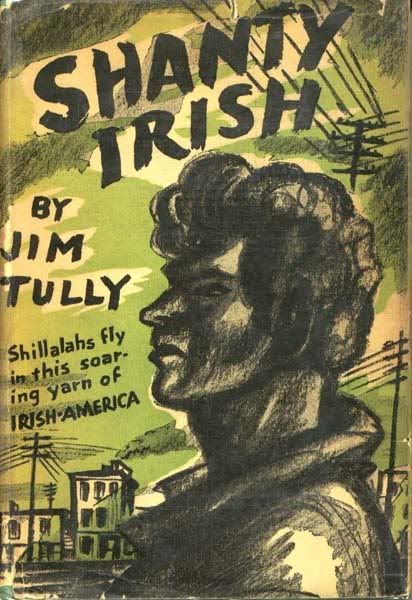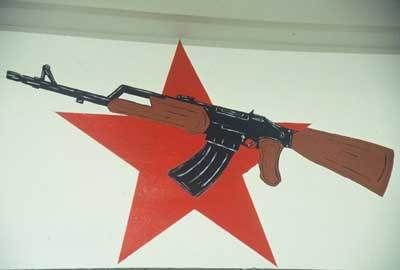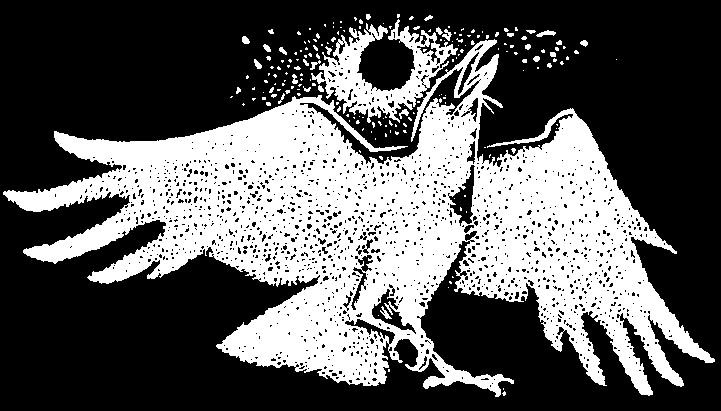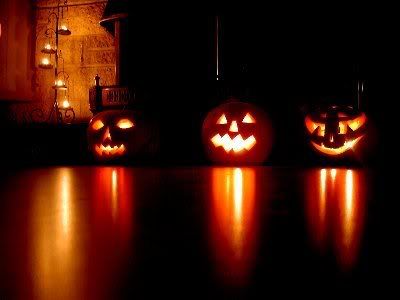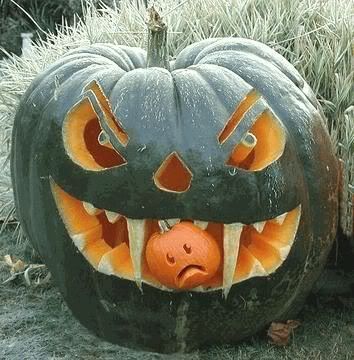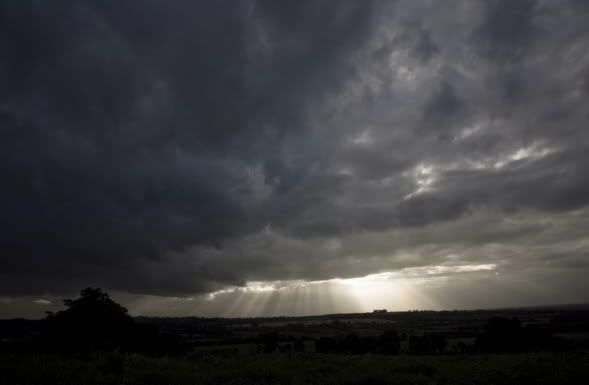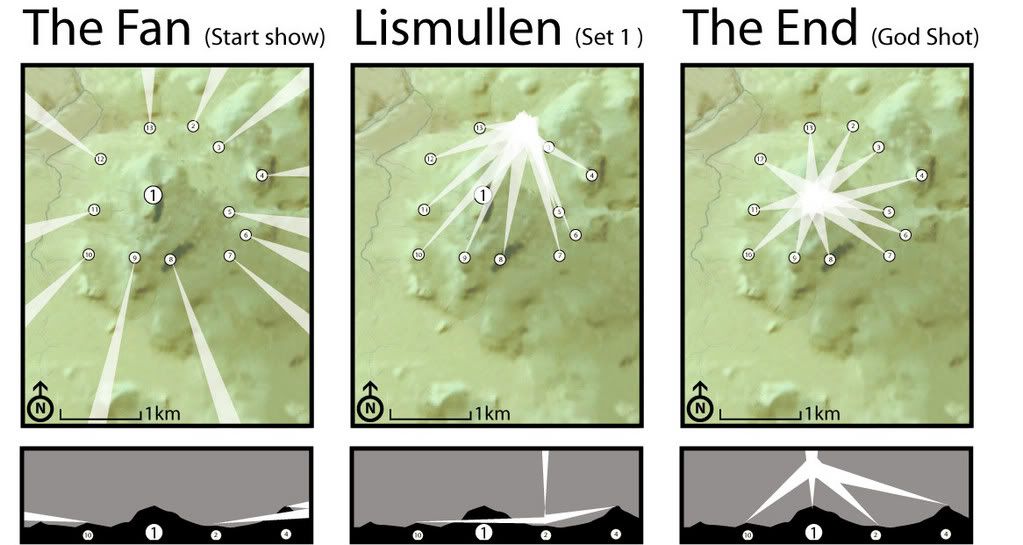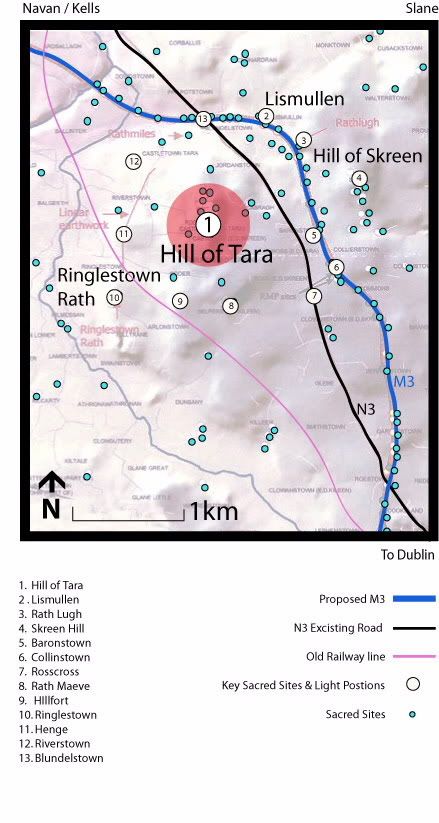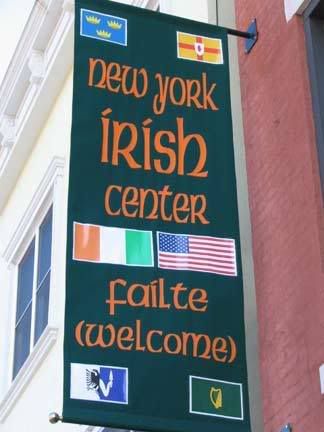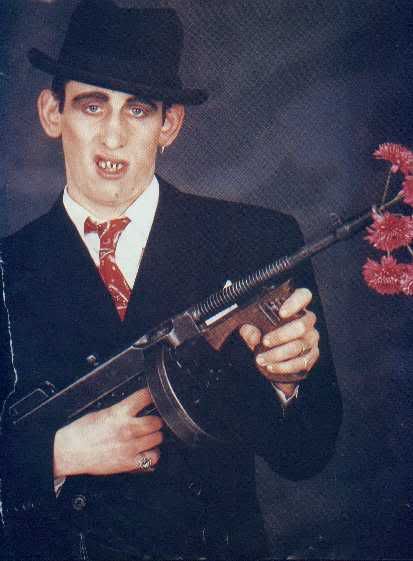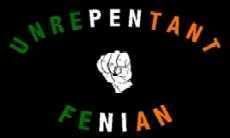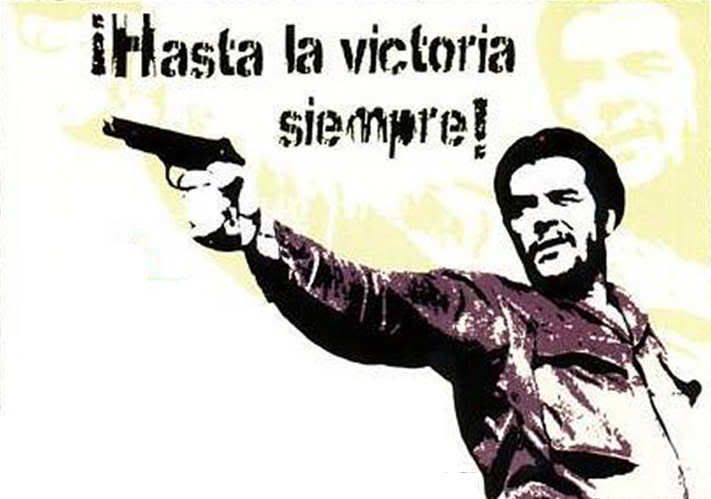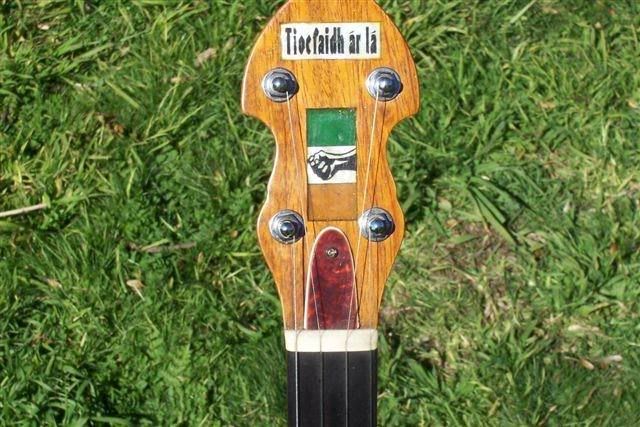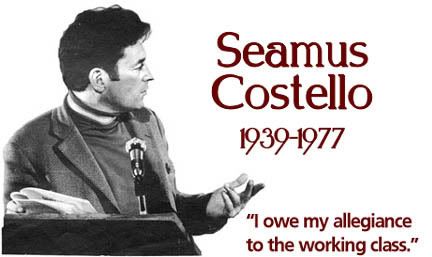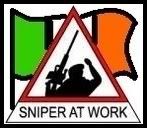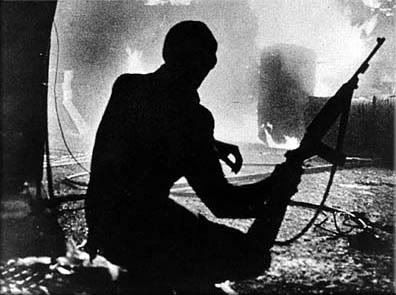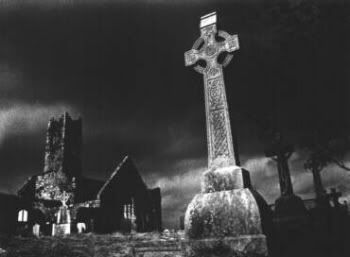 The Gaelic Origins of Halloween
The Gaelic Origins of Halloween
(from Wikipedia)
Halloween, or Hallowe'en, is a holiday celebrated on the night of October 31. Traditional activities include trick-or-treating, Halloween festivals, bonfires, costume parties, visiting "haunted houses" and viewing horror films. Halloween originated from the Pagan festival Samhain, celebrated among the Celts of Ireland , Cornwall, Wales and Scotland. Irish and Scottish immigrants carried versions of the tradition to North America in the nineteenth century. Other western countries embraced the holiday in the late twentieth century. Halloween is now celebrated in several parts of the western world, most commonly in Ireland, the United States, Canada, Puerto Rico, and the United Kingdom.
The term Halloween (and its alternative rendering Hallowe'en) is shortened from All-hallow-evening, as it is the eve of "All Hallows' Day", also which is now known as All Saints' Day. It was a day of religious festivities in various northern European Pagan traditions, until Popes Gregory III and Gregory IV moved the old Christian feast of All Saints' Day from May 13 to November 1. In the ninth century, the Church measured the day as starting at sunset, in accordance with the Florentine calendar. Although All Saints' Day is now considered to occur one day after Halloween, the two holidays were, at that time, celebrated on the same day. Liturgically, the Church traditionally celebrated that day as the Vigil of All Saints, and, until 1970, a day of fasting as well. Like other vigils, it was celebrated on the previous day if it fell on a Sunday, although secular celebrations of the holiday remained on the 31st. The Vigil was suppressed in 1955, but was later restored in the post-Vatican II calendar.
Many European cultural traditions, in particular Celtic cultures, hold that Halloween is one of the liminal times of the year when spirits can make contact with the physical world, and when magic is most potent (according to, for example, Catalan mythology about witches and Irish tales of the
Sídhe).
 HISTORY
HISTORY
The modern holiday of Halloween has its origins in the ancient Gaelic festival known as Samhain from the Old Irish samain). The Festival of Samhain is a celebration of the end of the harvest season in Gaelic culture, and is erroneously regarded as 'The Celtic New Year'. Traditionally, the festival was a time used by the ancient pagans to take stock of supplies and slaughter livestock for winter stores. The Ancient Gaels believed that on October 31, the boundaries between the worlds of the living and the dead overlapped and the deceased would come back to life and cause havoc such as sickness or damaged crops. The festivals would frequently involve bonfires, where the bones of slaughtered livestock were thrown. Costumes and masks were also worn at the festivals in an attempt to mimic the evil spirits or placate them. When the Romans occupied Celtic territory, several Roman traditions were also incorporated into the festivals. Feralia, a day celebrated in late October by the Romans for the passing of the dead as well as a festival which celebrated the Roman Goddess Pomona, the goddess of fruit were incorporated into the celebrations. The symbol of Pomona was an apple, which is a proposed origin for the tradition of bobbing for apples on Halloween.
AROUND THE WORLD
IRELAND
Snap-Apple Night by Daniel Maclise portrays a Halloween party in Blarney, Ireland, in 1832. The young people on the left side play various divination games, while children on the right bob for apples. A couple in the center play "Snap-Apple", which involves retrieving an apple hanging from a string.
Halloween is very popular in Ireland, where it is believed to have originated, and is known in Irish as Oíche Shamhna, literally "Samhain Night". Pre-Christian Celts had an autumn festival, Samhain "End of Summer", a pastoral and agricultural "fire festival" or feast, when the dead revisited the mortal world, and large communal bonfires would hence be lit to ward off evil spirits.
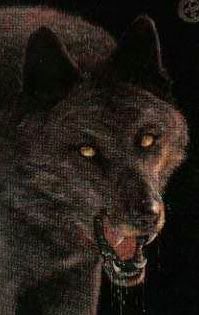
Yeee-Howl ! It's the Howling Wolf of Hallow's Eve and He's Mighty Hungry !
Pope Gregory IV standardized the date of All Saints' Day, or All Hallows' Day, on November 1 in the name of the entire Western Church in 835. As it now began at sunset, the holiday coincided exactly with Samhain. It is claimed that the choice of date seems consistent with the common practice of leaving pagan festivals and buildings intact (e.g., the Pantheon), while overlaying a Christian meaning.
Unfortunately, there is frustratingly little primary documentation of how Halloween was celebrated in preindustrial Ireland. Historian Nicholas Rogers has written:
"It is not always easy to track the development of Halloween in Ireland and Scotland from the mid-seventeenth century, largely because one has to trace ritual practices from [modern] folkloric evidence that do not necessarily reflect how the holiday might have changed; these rituals may not be "authentic" or "timeless" examples of pre-industrial times."
On Halloween night in present-day Ireland, adults and children dress up as creatures from the underworld (e.g., ghosts, ghouls, zombies, witches and goblins), light bonfires, and enjoy spectacular fireworks displays, despite the fact that such displays are usually illegal. Halloween was perceived as the night during which the division between the world of the living and the otherworld was blurred so spirits of the dead and inhabitants from the underworld were able to walk free on the earth. It was believed necessary to dress as a spirit or otherworldly creature when venturing outdoors to blend in, and this is where dressing in such a manner for Halloween comes from. This gradually evolved into trick-or-treating because children would knock on their neighbours' doors, in order to gather fruit, nuts, and sweets for the Halloween festival. Salt was once sprinkled in the hair of the children to protect against evil spirits.
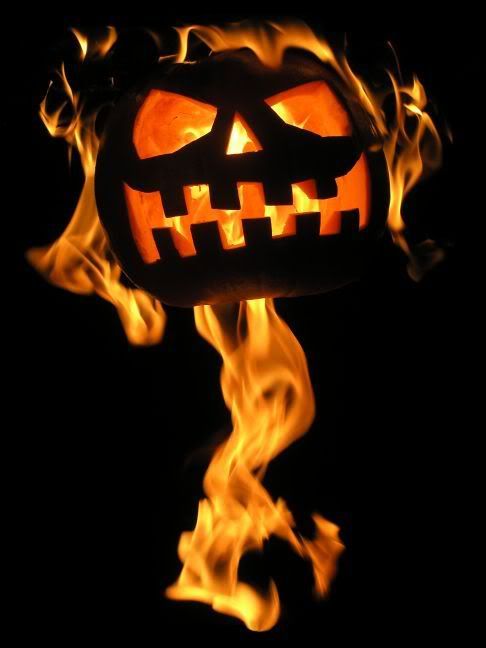
The houses are frequently adorned with pumpkins or turnips carved into scary faces; lights or candles are sometimes placed inside the carvings to provide an eerie effect. The traditional Halloween cake in Ireland is the barmbrack, which is a fruit bread. Barmbrack is the centre of an Irish Halloween custom. The Halloween Brack traditionally contained various objects baked into the bread and was used as a sort of fortune-telling game. In the barmbrack were: a pea, a stick, a piece of cloth, a small coin (originally a silver sixpence) and a ring. Each item, when received in the slice, was supposed to carry a meaning to the person concerned: the pea, the person would not marry that year; the stick, "to beat one's wife with", would have an unhappy marriage or continually be in disputes; the cloth or rag, would have bad luck or be poor; the coin, would enjoy good fortune or be rich; and the ring, would be married within the year. Commercially produced barmbracks for the Halloween market still include a toy ring.
Games are often played, such as bobbing for apples, where apples, peanuts and other nuts and fruit and some small coins are placed in a basin of water. The apples and nuts float, but the coins, which sink, are harder to catch. Everyone takes turns catching as many items possible using only their mouths. In some households, the coins are embedded in the fruit for the children to "earn" as they catch each apple. The Scottish and English have adapted the tradition to a game named "ducking", in which a participant quickly dunks in a water-filled container in an attempt to get a prize, without being submerged too long. Another common game involves the hands-free eating of an apple hung on a string attached to the ceiling. Games of divination are also played at Halloween, but are becoming less popular.
Irish children have a week-long Halloween break from school; the last Monday in October is a public holiday given for Halloween even though they often do not fall on the same day.
SCOTLAND
Scotland, having a shared Gaelic culture and language with Ireland, has celebrated the festival of Samhain robustly for centuries. Robert Burns portrayed the varied customs in his poem "Hallowe'en" (1785).
Halloween, known in Scottish Gaelic as "Oidhche Shamhna", consists chiefly of children going door to door "guising", i.e., dressed in a disguise (often as a witch or ghost) and offering entertainment of various sorts. If the entertainment is enjoyed, the children are rewarded with gifts of sweets, fruits or money. There is no Scottish 'trick or treat' tradition; on the contrary, 'trick or treat' may have its origins in the guising customs.
In Scotland a lot of folklore, including that of Halloween, revolves around the belief in faeries. Children dress up in costumes and carry around a "Neepy Candle," a devil face carved into a hollowed out Neep, lit from inside, to frighten away the evil faeries.
Popular children's games played on the holiday include "dookin" for apples (i.e., retrieving an apple from a bucket of water using only one's mouth). In places, the game has been replaced (because of fears of contracting saliva-borne illnesses in the water) by standing over the bowl holding a fork in one's mouth, and releasing it in an attempt to skewer an apple using only gravity. Another popular game is attempting to eat, while blindfolded, a treacle-coated scone on a piece of string hanging from the ceiling.
ISLE OF MAN
The Manx traditionally celebrate Hop-tu-Naa on October 31. This ancient Celtic tradition has parallels with Scottish and Irish traditions.
ENGLAND AND WALES
All Saints' Day (All Hallows Day) became fixed on November 1, 835, and All Souls' Day on November 2, circa 998. On All Souls' Eve, families stayed up late, and little "soul cakes" were eaten by everyone. At the stroke of midnight there was solemn silence among households, which had candles burning in every room to guide the souls back to visit their earthly homes, and a glass of wine on the table to refresh them. The tradition continued in areas of northern England as late as the 1930s, with children going from door-to-door "souling" (i.e., singing songs) for cakes or money. The English Reformation in the 16th century de-emphasised holidays like All Hallows Day and its associated eve. With the rise of Guy Fawkes Night celebrations in 17th century England, many Halloween practices, especially the building of bonfires, were moved to November 5.
Halloween celebrations in the UK were repopularised in the 1980s with influence from America, and saw the reintroduction of traditions such as pumpkin carvings and trick-or-treat.[citation needed] Between 2001 and 2006, consumer spending in the UK for Halloween rose tenfold from £12m to £120m, according to Bryan Roberts from industry analysts Planet Retail, making Halloween the third most profitable holiday for supermarkets.[10] Nowadays, adults often dress up to attend costume parties, pub parties and club parties on Halloween night.
In parts of England, there is a similar festival called holy day which falls on the November 4. During the celebration, children play a range of "tricks" (ranging from minor to more serious) on adults. One of the more serious "tricks" might include the unhinging of garden gates (which were often thrown into ponds, or moved far away). In recent years, such acts have occasionally escalated to extreme vandalism, sometimes involving street fires.
Throughout England (and much of the British Isles), children carve faces or designs into hollowed-out pumpkins. Usually illuminated from within, the lanterns are displayed in windows in keeping with the night's theme of fright and horror. (See article Jack-o'-lantern.) Before the introduction of pumpkin carving from the United States, it was common to carve large swedes (a.k.a. neeps or yellow turnips), which is still done in some areas.
Bobbing for apples is a well-established Halloween custom, synonymous with the Scottish "dukin". In the game, apples were placed in a water-filled barrel, and a participant would attempt to catch an apple with one's mouth only. Once an apple was caught, it would be peeled and tossed over the shoulder in the hope that the strips would fall into the shape of a letter, which would supposedly be the first initial of the participant's true love. According to another superstition, the longer the peel, the longer the peeler's life would be; some say that the first participant to get an apple would be the first to marry.
Other Halloween festivities include fireworks, telling ghost stories, and playing children's games such as hide-and-seek. Apple tarts might be baked with a coin hidden inside, and nuts of all types are traditional Halloween fare. Bolder children may play a game called "thunder and lightning", which involves loudly knocking on a neighbor's door, then running away (like lightning). This game is known as "knock-door-run", "knock-and-run", "knock-knock-zoom-zoom", "ding-dong-ditch", or "postman's knock" in parts of the country, and is also played on Mischief Night. Tradition has been changing, as the majority of today's children will arrive at a door and intone "trick-or-treat" in order to receive money and sweets.
There has been increasing concern about the potential for antisocial behavior, particularly among older teens, on Halloween. Cases of houses being "egg-bombed" (especially when the occupants do not give money or gifts) have been reported, and the BBC reports that for Halloween 2006 police forces have stepped up patrols to respond to such mischief.
USA AND CANADA
Halloween did not become a holiday in the United States until the 19th century, where lingering Puritan tradition restricted even the observance of Christmas prior to the 1800s. American almanacs of the late 18th and early 19th centuries do not include Halloween in their lists of holidays. The transatlantic migration of nearly two million Irish following the Irish Potato Famine (1845–1849) finally brought the holiday to the United States. Scottish emigration from the British Isles, primarily to Canada before 1870 and to the United States thereafter, brought the Scottish version of the holiday to each country.
Scottish-American and Irish-American societies held dinners and balls that celebrated their heritages, with perhaps a recitation of Robert Burns' poem "Halloween" or a telling of Irish legends, much as Columbus Day celebrations were more about Italian-American heritage than Columbus per se. Home parties would center around children's activities, such as bobbing for apples, and various divination games often concerning future romance. Not surprisingly, pranks and mischief were common as well.
The commercialization of Halloween in the United States did not start until the 20th century, beginning perhaps with Halloween postcards (featuring hundreds of designs) which were most popular between 1905 and 1915. Dennison Manufacturing Company, which published its first Hallowe'en catalog in 1909, and the Beistle Company were pioneers in commercially made Halloween decorations, particularly die-cut paper items. German manufacturers specialised in Halloween figurines that were exported to the United States in the period between the two world wars.
There is little primary documentation of masking or costuming on Halloween in the United States or elsewhere, prior to 1900. Mass-produced Halloween costumes did not appear in stores until the 1930s, and trick-or-treating did not become a fixture of the holiday until the 1950s.
In the United States, Halloween has become the sixth most profitable holiday (after Christmas, Mother's Day, Valentines Day, Easter, and Father's Day). In the 1990s, many manufacturers began producing a larger variety of Halloween yard decorations; prior to this a majority of decorations were homemade. Some of the most popular yard decorations are jack-o'-lanterns, scarecrows, witches, orange and purple string lights, inflatable decorations (such as spiders, pumpkins, mummies and vampires), and animatronic window and door decorations. Other popular decorations are foam tombstones and gargoyles. Halloween is now the United States' second most popular holiday (after Christmas) for decorating; the sale of candy and costumes are also extremely common during the holiday, which is marketed to children and adults alike. According to the National Retail Federation, the most popular Halloween costume themes for adults are, in order: witch, pirate, vampire, cat and clown. On many college campuses, Halloween is a major celebration, with the Friday and Saturday nearest October 31 hosting many costume parties.
Universal's Halloween Horror Nights is one of the largest and most elaborate Halloween events in the world. The month-long event takes place at Universal Studios theme parks in Florida and Hollywood.
The National Confectioners Association reported, in 2005, that 80 percent of American adults planned to give out candy to trick-or-treaters, and that 93 percent of children planned to go trick-or-treating.
Anoka, Minnesota, the self-proclaimed "Halloween Capital of the World", celebrates the holiday with a large civic parade and several other city-wide events. Salem, Massachusetts, also has laid claim to the "Halloween Capital" title, while trying to dissociate itself from its history of persecuting witchcraft. At the same time, however, the city does see a great deal of tourism surrounding the Salem witch trials, especially around Halloween. In the 1990s, the city added an official "Haunted Happenings" celebration to the October tourist season.. Nearby Keene, New Hampshire, hosts the annual Pumpkin Fest each October which previously held the record for having the greatest number of lit jack-o'-lanterns at once. (Boston, Massachusetts holds the record as of October 2006).
Rutland, Vermont has hosted the annual Rutland Halloween Parade since 1960. Tom Fagan, a local comic book fan, is credited with having a hand in the parade's early development and superhero theme. In the early 1970s, the Rutland Halloween Parade achieved a degree of fame when it was used as the setting of a number of superhero comic books, including Batman #237, Justice League of America #103, Amazing Adventures #16 and The Mighty Thor #207.
Ubu Apocalypse, a presentation of over-sized papier-mâché masks at the Village Halloween Parade in New York City.New York City hosts the United States' largest Halloween celebration, known as The Village Halloween Parade. Started by Greenwich Village mask maker Ralph Lee in 1973, the evening parade now attracts over two million spectators and participants, as well as roughly four million television viewers annually. It is the largest participatory parade in the country if not the world, encouraging spectators to march in the parade as well.
In many towns and cities, trick-or-treaters are welcomed by lit porch lights and jack-o'-lanterns. In some large and/or crimeridden areas, however, trick-or-treating is discouraged, or refocused to staged trick-or-treating events within nearby shopping malls, in order to prevent potential acts of violence against trick-or-treaters. Even where crime is not an issue, many American towns have designated specific hours for trick-or-treating, e.g., 5-7 pm or 5-8 pm, to discourage late-night trick-or-treating.
Those living in the country may hold Halloween parties, often with bonfires, with the celebrants passing between them. The parties usually involve traditional games (like snipe hunting, bobbing for apples, or searching for candy in a similar manner to Easter egg hunting), haunted hayrides (often accompanied by scary stories, and costumed people hiding in the dark to jump out and scare the riders), and treats (usually a bag of candy and/or homemade treats). Scary movies may also be viewed. Normally, the children are picked up by their parents at predetermined times. However, it is not uncommon for such parties to include sleepovers.
Trick-or-treating may often end by early evening, but the nightlife thrives in many urban areas. Halloween costume parties provide an opportunity for adults to gather and socialize. Urban bars are frequented by people wearing Halloween masks and risqué costumes. Many bars and restaurants hold costume contests to attract customers to their establishments. Haunted houses are also popular in some areas.
MEXICO
In Mexico, Halloween has been celebrated during the last 40 years where the celebrations have been influenced by the American traditions, such as the costuming of children who visit the houses of their neighbourhood in search of candy. Though the "trick-or-treat" motif is used, tricks are not generally played on residents not providing candy. Older crowds of preteens, teenagers and adults will sometimes organize Halloween-themed parties, which might be scheduled on the nearest available weekend.
Halloween in Mexico begins three days of consecutive holidays, as it is followed by All Saints' Day, which also marks the beginning of the two day celebration of the Day of the Dead or the Día de los Muertos. This might account for the initial explanations of the holiday having a traditional Mexican-Catholic slant.
AUSTRALIA & NEW ZEALAND
In the southern hemisphere, spring is in full swing by October 31, and the days are rapidly growing longer and brighter. This does not mesh well with the traditional Celtic spirit of Halloween, which relies on an atmosphere of the encroaching darkness of winter.
However, Halloween has recently gained a large amount of recognition in Australia and to an extent New Zealand, largely due to American media influences. In 2006, costume shops reported a rise in sales on Halloween-themed costumes,[citation needed] on October 31, 2006. On Halloween night, horror films and horror-themed TV episodes are traditionally aired.
CHINA
There is no Halloween in Chinese tradition, but there is a similar Chinese holiday called Ghost Festival. The Ghost Festival is a traditional Chinese festival and holiday, which is celebrated by Chinese people in many countries. In the Chinese calendar (a lunisolar calendar), the Ghost Festival is on the 14th night of the seventh lunar month, which is called Ghost Day. In Chinese tradition, the ghosts and spirits, including those of the deceased ancestors, come out from the lower world.
Hong Kong, a former British colony, does celebrate Halloween every year unlike the Mainland.
OTHER REGIONS
In other regions such as Japan, Halloween has become popular in the context of American pop culture. Some Catholics do not appreciate the resultant de-emphasis of the more spiritual aspects of All Hallows Eve and Reformation Day, respectively, or of regional festivals occurring around the same time (such as St Martin's Day). Business has a natural tendency to capitalize on the holiday season's more commercial aspects, such as the sale of decorations and costumes.
HALLOWEEN SYMBOLS
Jack-o'-lanterns are often carved into silly or scary faces.The carved pumpkin, lit by a candle inside, is one of Halloween's most prominent symbols. This is an Irish tradition of carving a lantern which goes back centuries. These lanterns are usually carved from a turnip or swede (or more uncommonly a mangelwurzel). The carving of pumpkins was first associated with Halloween in North America,where the pumpkin was available, and much larger and easier to carve. Many families that celebrate Halloween carve a pumpkin into a frightening or comical face and place it on their home's doorstep after dark.
The jack-o'-lantern can be traced back to the Irish legend of Stingy Jack, a greedy, gambling, hard drinking old farmer who tricked the devil into climbing a tree, and trapped him by carving a cross into the trunk of the tree. In revenge, the devil placed a curse on Jack which dooms him to forever wander the earth at night. For centuries, the bedtime parable was told by Irish parents to their children. But in America the tradition of carving pumpkins is known to have preceded the Great Famine period of Irish immigration,[24] and the tradition of carving vegetable lanterns may also have been brought over by the Scottish or English; documentation is unavailable to establish when or by whom. The carved pumpkin was associated generally with harvest time in America, and did not become specifically associated with Halloween until the mid to late 19th century.
The imagery surrounding Halloween is largely an amalgamation of the Halloween season itself, nearly a century of work from American filmmakers and graphic artists, and a rather commercialized take on the dark and mysterious. Halloween imagery tends to involve death, magic, or mythical monsters. Common Halloween characters include ghosts, ghouls, witches, vampires, bats, owls, crows, vultures, haunted houses, pumpkinmen, black cats, aliens, spiders, goblins, zombies, mummies, skeletons, and demons. Particularly in America, symbolism is inspired by classic horror films, which contain fictional figures like Dracula, Frankenstein's monster, and The Mummy. More modern horror antagonists like Freddy Krueger, Michael Myers, Leatherface, Jason Voorhees, and the Jigsaw Killer have also become associated with the holiday. Homes are often decorated with these symbols around Halloween.
Black and orange are the traditional colors of Halloween.
TRICK OR TREATING & GUISING
United States and Canada
The main event for children of modern Halloween in the United States and Canada is trick-or-treating, in which children disguise themselves in costumes and go door-to-door in their neighborhoods, ringing each doorbell and yelling "trick or treat!" to solicit the usual gift of candies. Although the practice resembles the older traditions of guising in Ireland and Scotland, ritual begging on Halloween does not appear in English-speaking North America until the 20th century, and may have developed independently. Upon receiving trick-or-treaters, the house occupants (who might also be in costume) often hand out small candies, miniature chocolate bars, loose change, soda pop, stickers, or even crayons and pencils (some people even give out their business cards).[citation needed] Some homes will use sound effects and fog machines to help establish an eerie atmosphere. Other less scary house decoration themes might be used to entertain younger visitors. Children can often accumulate many treats on Halloween night, filling up entire pillow cases, pumpkin-shaped buckets, shopping bags or large plastic containers.
IRELAND
In places of Ireland, huge bonfires are lit. Young children in disguise are gladly received by the neighbors with "fruit, miniature chocolate bars, loose change, peanuts and of course sweets" for the "Halloween Party", whilst older male siblings play innocent pranks on their bewildered victims. Some homes will put up decorations including Halloween lights. Since schoolchildren have the week off for Halloween, it is common for teenagers and college students to spend weeknights out with friends pranking and causing mischief, if not trick-or-treating themselves.
UK
In Scotland, children or guisers are more likely to recite "The sky is blue, the grass is green, may we have our Halloween" instead of "trick or treat!" Walking in groups, the children visit neighbors and must impress them with a song, poem, trick, joke or dance in order to earn treats. Traditionally, nuts, oranges, apples and dried fruit were offered, though children might earn a small amount of cash, usually a sixpence. (Participation was also open to very young children, for whom the experience of performing could be more terrifying than ghosts and goblins).
In England, trick-or-treating does occur, particularly in working class neighborhoods. In general, however, the practice is regarded as a nuisance at best and a menacing form of begging at worst. In some areas, households have started to put decorations on the front door to indicate that 'trick-or-treaters' are welcome, the idea being that 'trick-or-treaters' avoid a house not 'participating' in the custom. Tricks currently play a less prominent role, though Halloween night is often marked by vandalism such as soaping windows, egging houses or stringing toilet paper through trees. Before indoor plumbing was ubiquitous, tipping over or displacing outhouses was a popular form of vandalism. Casting flour into the faces of feared neighbors was also common practice at one time.
SAMHAIN
Samhain is the word for November in the Gaelic languages. The Scottish Gaelic spelling is Samhainn or Samhuinn (for the feast), or an t-Samhain (for the month). The Festival of Samhain is a celebration of the end of the harvest season in Gaelic culture, and is generally regarded as 'The Celtic New Year'.
The same word was used for a month in the ancient Celtic calendar, in particular the first three nights of this month, with the festival marking the end of the summer season and the end of the harvest. A modernized version of this festival continues today in some of the traditions of the Catholic All Souls' Day, the secular Halloween, and in folk practices of Samhain itself in the Celtic Nations and the Irish and Scottish diasporas. It is also observed by various types of Neopagans.
SAMHAIN AMONGST THE ANCIENT CELTS
The Gaulish calendar appears to have divided the year into two halves: the 'dark' half, beginning with the month Samonios (the October/November lunation), and the 'light' half, beginning with the month Giamonios (the April/May lunation). The entire year may have been considered as beginning with the 'dark' half, so that the beginning of Samonios may be considered the Celtic New Year's day. The celebration of New Year itself may have taken place during the 'three nights of Samonios' (Gaulish trinux[tion] samo[nii]), the beginning of the lunar cycle which fell nearest to the midpoint between the autumnal equinox and the winter solstice. The lunations marking the middle of each half-year may also have been marked by specific festivals. The Coligny calendar marks the mid-summer moon (see Lughnasadh), but omits the mid-winter one (see Imbolc). The seasons are not oriented at the solar year, viz. solstice and equinox, so the mid-summer festival would fall considerably later than summer solstice, around 1 August (Lughnasadh). It appears that the calendar was designed to align the lunations with the agricultural cycle of vegetation, and that the exact astronomical position of the Sun at that time was considered less important.
In medieval Ireland, Samhain remained the principal festival, celebrated with a great assembly at the royal court in Tara, lasting for three days, consistent with the Gaulish testimony.
SAMHAIN IN IRISH CELTIC LEGEND
The Ulster Cycle is peppered with references to Samhain. Many of the adventures and campaigns undertaken by the characters therein begin at the Samhain Night feast.
One such tale is Echtra Nerai ('The Adventure of Nera') concerning one Nera from Connacht who undergoes a test of bravery put forth by King Ailill. The prize is the king's own gold-hilted sword. The terms hold that a man must leave the warmth and safety of the hall and pass through the night to a gallows where two prisoners had been hanged the day before, tie a twig around one man's ankle, and return. Others had been thwarted by the demons and spirits that harassed them as they attempted the task, quickly coming back to Ailill's hall in shame. Nera goes on to complete the task and eventually infiltrates the sídhe where he remains trapped until the end of the world. Taking etymology into consideration, it is interesting to note that the word for summer expressed in the Echtra Nerai is samraid.
The Cath Maige Tuireadh (Battle of Mag Tuired) takes place on Samhain. The deities Morrígan and Dagda meet and have sex before the battle against the Fomorians; in this way the Morrígan acts as a sovereignty figure and gives the victory to The Dagda's people, the Tuatha Dé Danann.
SAMHAIN IN CELTIC FOLKLORE
The Samhain celebrations have survived in several guises as a festival dedicated to the harvest and the dead. In Ireland and Scotland, the Féile na Marbh, the 'festival of the dead' took place on Samhain.
The night of Samhain, in Irish, Oíche Shamhna and Scots Gaelic, Oidhche Shamhna, is one of the principal festivals of the Celtic calendar, and falls on the 31st of October. It represents the final harvest. In modern Ireland and Scotland, the name by which Halloween is known in the Gaelic language is still Oíche/Oidhche Shamhna. It is still the custom in some areas to set a place for the dead at the Samhain feast, and to tell tales of the ancestors on that night.
Traditionally, Samhain was time to take stock of the herds and grain supplies, and decide which animals would need to be slaughtered in order for the people and livestock to survive the winter. This custom is still observed by many who farm and raise livestock.
Bonfires played a large part in the festivities celebrated down through the last several centuries, and up through the present day in some rural areas of the Celtic nations and the diaspora. Villagers were said to have cast the bones of the slaughtered cattle upon the flames. In the pre-Christian Gaelic world, cattle were the primary unit of currency and the center of agricultural and pastoral life. Samhain was the traditional time for slaughter, for preparing stores of meat and grain to last through the coming winter. The word 'bonfire', or 'bonefire' is a direct translation of the Gaelic tine cnámh. With the bonfire ablaze, the villagers extinguished all other fires. Each family then solemnly lit its hearth from the common flame, thus bonding the families of the village together. Often two bonfires would be built side by side, and the people would walk between the fires as a ritual of purification. Sometimes the cattle and other livestock would be driven between the fires, as well.
Divination, usually involving apples and nuts, is a common folkloric practice that has also survived in rural areas. The most common uses were to determine the identity of one's future spouse, the location of one's future home, and how many children a person might have. Children would also chase crows and divine some of these things from the direction the birds flew.
In parts of western Brittany, Samhain is still heralded by the baking of kornigou, cakes baked in the shape of antlers to commemorate the god of winter shedding his 'cuckold' horns as he returns to his kingdom in the Otherworld. The Romans identified Samhain with their own feast of the dead, the Lemuria. This, however, was observed in the days leading up to May 13. With Christianization, the festival in November (not the Roman festival in May) became All Hallows' Day on November 1st followed by All Souls' Day, on November 2nd. Over time, the night of October 31 came to be called All Hallow's Eve, and the remnants festival dedicated to the dead eventually morphed into the secular holiday known as Halloween.
ETYMOLOGY
The Irish word Samhain is derived from the Old Irish samain, samuin, or samfuin, all referring to 1 November (latha na samna: 'samhain day') and the festival and royal assembly held on that date in medieval Ireland (oenaig na samna: 'samhain assembly'). Its meaning is glossed as 'summer's end', and the frequent spelling with f suggests analysis by popular etymology as sam ('summer') and fuin ('sunset', 'end'). The Old Irish sam ('summer') is from Proto-Indo-European language (PIE) *semo-; cognates are Welsh haf, Breton hañv, English summer and Old Norse language sumar, all meaning 'summer', and the Sanskrit sáma ("season").
Whitley Stokes in KZ 40:245 (1907) suggests an etymology from Proto-Celtic *samani ('assembly'), cognate to Sanskrit sámana, and the Gothic samana. J. Vendryes in Lexique Étymologique de l'Irlandais Ancien (1959) concludes that these words containing *semo- ('summer') are unrelated to samain, remarking that furthermore the Celtic 'end of summer' was in July, not November, as evidenced by Welsh gorffennaf ('July'). We would therefore be dealing with an Insular Celtic word for 'assembly', *samani or *samoni, and a word for 'summer', saminos (derived from *samo-: 'summer') alongside samrad < *samo-roto-. The Irish samain would be etymologically unrelated to 'summer', and derive from 'assembly'. But note that the name of the month is of Proto-Celtic age, cf. Gaulish SAMON[IOS] from the Coligny calendar, and the association with 'summer' by popular etymology may therefore in principle date to even pre-Insular Celtic times.
Confusingly, Gaulish Samonios (October/November lunation) corresponds to GIAMONIOS, the seventh month (the April/May lunation) and the beginning of the summer season. Giamonios, the beginning of the summer season, is clearly related to the word for winter, Pan-Indo-European *g'hei-men- (Latin hiems, Slavic zima, Greek kheimon, Hittite gimmanza), cf. Old Irish gem-adaig ('winter's night'). It appears, therefore, that in Proto-Celtic the first month of the summer season was named 'wintry', and the first month of the winter half-year 'summery', possibly by ellipsis, '[month at the end] of summer/winter', so that samfuin would be a restitution of the original meaning after all. This interpretation would either invalidate the 'assembly' explanation given above, or push back the time of the re-interpretation by popular etymology to very early times indeed.
Bealtaine, Lúnasa and Samhain are still today the names of the months of May, August and November in the Irish language. Similarly, an Lùnasdal and an t-Samhain are the modern Scots Gaelic names for August and November.
NEOPAGANISM
Samhain is observed by various Neopagans in various ways. As forms of Neopaganism can be quite different and have very different origins, these representations can vary considerably despite the shared name. Some Neopagans have elaborate rituals to honor the dead, and the deities who are associated with the dead in their particular culture or tradition. Some celebrate in a manner as close as possible to how the Ancient Celts and Living Celtic cultures have maintained the traditions, while others observe the holiday with rituals culled from numerous other unrelated sources, Celtic culture being only one of the sources used.
CELTIC RECONSTRUCTIONISM
Celtic Reconstructionist Pagans tend to celebrate Samhain on the date of first frost, or when the last of the harvest is in and the ground is dry enough to have a bonfire. Like other Reconstructionist traditions, Celtic Reconstructionists place emphasis on historical accuracy, and base their celebrations and rituals on traditional lore from the living Celtic cultures, as well as research into the older beliefs of the polytheistic Celts. At bonfire rituals, some observe the old tradition of building two bonfires, which celebrants and livestock then walk or dance between as a ritual of purification.
According to Celtic lore, Samhain is a time when the boundaries between the world of the living and the world of the dead become thinner, at times even fading away completely, allowing spirits and other supernatural entities to pass between the worlds to socialize with humans. It is the time of the year when ancestors and other departed souls are especially honored. Though Celtic Reconstructionists make offerings to the spirits at all times of the year, Samhain in particular is a time when more elaborate offerings are made to specific ancestors. Often a meal will be prepared of favorite foods of the family's and community's beloved dead, a place set for them at the table, and traditional songs, poetry and dances performed to entertain them. A door or window may be opened to the west and the beloved dead specifically invited to attend. Many leave a candle or other light burning in a western window to guide the dead home. Divination for the coming year is often done, whether in all solemnity or as games for the children. The more mystically inclined may also see this as a time for deeply communing with the deities, especially those whom the lore mentions as being particularly connected with this festival
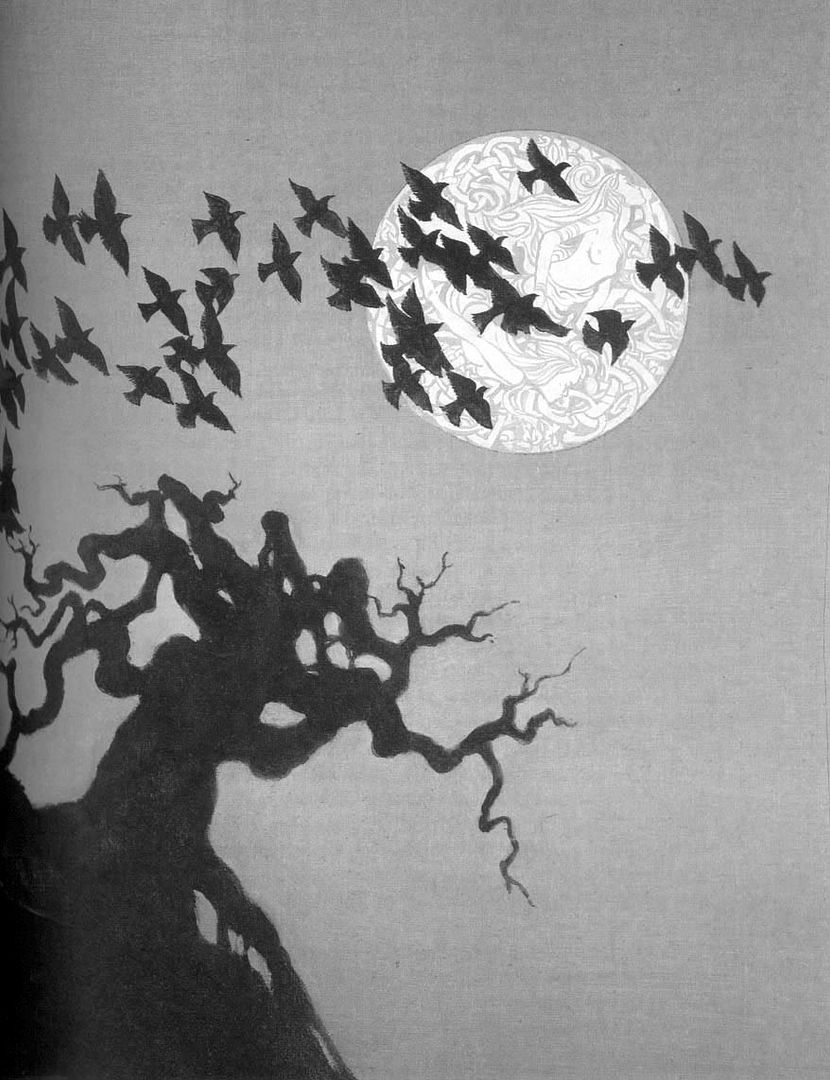
Radio Rebel Gael



